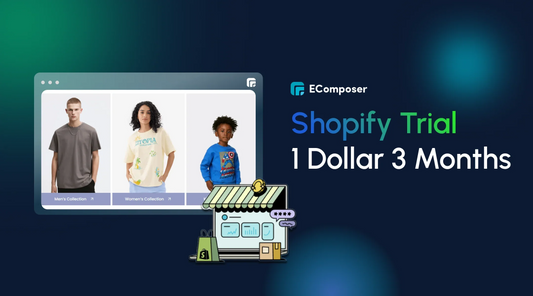Is Shop Pay Safe? Explanation, Reviews & Alternatives (2025)

Table Of Contents
Online shoppers and merchants know that an easy checkout process determines whether customers make purchases. Shop Pay emerges as a secure payment service that speeds up checkout processes and minimizes checkout obstacles while offering maximum safety to online shoppers. But how safe is it?
When you pause before buying on Shop Pay due to payment security concerns or differences from rival payment methods, you are part of a common experience. Most people who conduct online shopping and those who run online stores continue to ask similar questions. Every online merchant should review Shop Pay in 2025 by studying its security features while reading user feedback and considering substitute payment methods to guide their store's payment choices. Let’s explore now!
What is Shop Pay?
Shop Pay represents a Shopify-created enhanced checkout solution that streamlines online buying transactions for customers and merchants during purchases. Shop Pay provides secure storage for payment details and shipping information, and user contact information to let customers finish transactions swiftly through a few clicks without entering repetitive purchase info. Additionally, Shop Pay streamlines checkouts while preventing customers from leaving their carts empty, which turns this into a crucial asset for digital businesses.
Shop Pay features & functionality
Shop Pay delivers an exceptional, user-friendly interface with modern features that deliver value for customers and sellers. Shop Pay offers the following distinct features, which I will explain in detail:
1. Accelerated Checkout:
The checkout procedure becomes faster through Shop Pay because it securely manages user payment information, shipping details, and contact data. Users can finish their purchases with one simple click through Shop Pay because they do not need to enter purchase information repeatedly. The convenience of streamlined checkout through Shop Pay both enhances purchasing speed and decreases user drop-off to increase conversions.
2. Shop Pay Installments:
One of the most appealing features of Shop Pay is the installment payment option. This “buy now, pay later” model allows customers to Break up their payments with no interest or minimal fees over time. By offering more flexible payment terms, merchants can attract a wider audience and encourage larger order values, while customers can afford bigger-ticket items without a single upfront payment.
3. Real-Time Order Tracking:
Once a purchase is made, customers can track their orders in real time through the Shop app. Shop Pay’s integration with Shopify’s ecosystem provides detailed updates on shipping progress, delivery status, and order history. Transparency goes a long way in gaining customer trust and keeping them coming back by keeping them informed every step of the way.
4. Sustainability Initiatives:
Shop Pay differentiates itself by providing support for environmentally friendly practices. Through Shopify sustainability programs, Shop Pay enables the reduction of carbon emissions during deliveries thus making it an environmentally friendly payment gateway for commercial and residential customers. Modern shoppers prioritize sustainability when making buying choices; therefore, the emphasis on green initiatives attracts them to Shop Pay.
5. Secure Payment Processing:
At its core, Shop Pay provides security features to its users as a primary function. The system implements enhanced security protocols alongside PCI DSS standard compliance, which protects its customers' sensitive data, containing information about credit card details and personal things. Two-factor authentication in transaction processing creates additional security layers that help customers trust the reliability of the platform.
6. Integration with Multiple Sales Channels:
Shop Pay functions smoothly within Shopify’s platform without restricting itself to Shopify-based stores alone. Shop Pay provides merchants using the Facebook and Instagram platforms access to let customers finish their purchases within the applications. The platform provides businesses with enhanced capabilities to track sales from different platforms through one system, which maintains a unified checkout process for customers.
7. Customizable Merchant Settings:
Merchants using Shop Pay obtain the flexibility to modify their appearance and functionality on their stores. Businesses using the checkout button can personalize their visual aspects while turning specific features on or off and controlling how shipping methods operate within their stores. Shop Pay delivers adaptable features to businesses that enable them to design their checkout process according to their operating structure and branding identity.
In summary, Shop Pay is more than just a quick checkout tool—it’s a robust, multifaceted payment solution designed to enhance the customer experience, boost conversions, and support sustainable commerce. With features ranging from installment payments to real-time order tracking and secure data handling, Shop Pay helps merchants grow their businesses while providing customers with a convenient and reliable shopping journey.
Is Shop Pay really secure? - Shop Pay security measures
Financial transaction safety stands as the main worry for both business owners and their customers when shopping online. The safety of Shop Pay requires further investigation because consumers doubt its security measures. Your online store can rely on Shop Pay because it incorporates structured security protocols for offering secure payment options.
1. Data Encryption at Every Step
Advanced encryption protocols protect all sensitive Shop Pay handling operations from beginning to end, which ensures safekeeping of payment data and personal information, including credit card numbers and email, and phone numbers. A customer enters payment information that Shop Pay encrypts before it sends the secure data through transmission. The information becomes an unrecognizable code that authorized systems alone can interpret while simultaneously blocking unauthorized viewing of personal data.
2. PCI DSS Compliance
PCI DSS is created to reduce credit card fraud and protect sensitive payment information provides certification standards that Pay complies with to reach industry-leading security standards. The certification also makes Shop Pay follow rigorous rules regarding how to handle payment information in terms of storage and transmission. The whole process features secure network protocols together with robust firewalls, which operate as protective measures against data breaches while maintaining user information safety.
3. Tokenization Technology
The safety features of Shop Pay enhance security through tokenization methods. The system does not keep actual credit card information but creates a useless token that functions as an alternative to raw data storage. Tokenization methodology diminishes the chance of exposing sensitive financial data, no matter what happens to the payment system.
4. Two-Factor Authentication (2FA)
When a customer uses Shop Pay, they’re prompted to enter a verification code you received via SMS. This two-factor authentication step helps confirm that the person completing the transaction is truly the account holder. Even if someone had access to saved credentials, they’d be unable to complete a purchase without the unique code sent to the customer’s device.
5. Fraud Detection and Prevention
Within Shop Pay, features include built-in fraud detection features that actively monitor all transactions. The system’s built-in detection tools automatically detect suspicious transactions in real time which results in blocking fraudulent purchases when they occur. Through proactive security measures, Shop Pay protects both the merchant’s business and prevents unauthorized transactions to customers.
6. Secure Shopify Ecosystem
Shop Pay benefits from the superior infrastructure of Shopify due to its operation within the Shopify platform ecosystem. Shopify maintains Level 1 PCI compliance standards as a service provider, which stands for the highest possible payment security requirements. The secure architecture provides consistent, strong protection for each transaction that takes place through Shop Pay.
Advantages of using Shop Pay for merchants & customers
The checkout-enhancing capability of Shop Pay forms an instrument that delivers actual benefits, which benefits both merchants and their customers. An exploration of Shop Pay’s benefits for all members of the online shopping process will follow in this discussion.
For Merchants:
- Higher Conversion Rates: The speed of a flawless checkout process increases finished orders which leads to enhanced conversion rates as well as higher revenue numbers.
- Improved Customer Loyalty: Your store’s reputation will grow alongside loyal customer relationships when you provide an established payment method because the trust it creates leads to continued purchasing activities.
- Higher Average Order Value: Your installment payment flexibility helps customers buy high-value items, thus producing elevated revenue from each transaction without requiring product expansion.
- Sustainability Benefits: Environmental sustainability plays an essential role in attracting customers dedicated to green choices because carbon-neutral deliveries help your store demonstrate eco-friendly values, which draw novice shoppers with sustainability preferences.
- Streamlined Store Management: Shop Pay operates within Shopify and provides operational simplification, together with analytical information that helps you expand your business by freeing you from payment management responsibilities.
For Customers:
- Quick transactions become possible through the customer payment and shipping information storage option, which eliminates the need to enter repetitive data frequently and thus improves shopping efficiency.
- Through its installment payment system, the company permits customers to pay for expensive goods through regular monthly installments, thus enabling them to acquire desired items without facing financial strain.
- The payment information stored by customers remains safe because advanced encryption works together with two-factor authentication protocols that ensure complete peace of mind for their transactions.
- Through the Shop App, customers can track order delivery status, so a friendly and secure shopping environment forms between them and the business.
- Eco-Friendly Shopping: The delivery service allows shoppers to buy items sustainably because their packages arrive carbon-neutral, so they can purchase responsibly without losing convenience.
Shop Pay vs. other payment methods
|
Feature/Criteria |
Shop Pay |
PayPal |
Stripe |
Apple Pay |
Afterpay/Klarna |
|
Speed and Convenience |
Very fast, one-click checkout |
Fast, but requires a login |
Fast, but no saved customer data |
Fast, integrated into iOS devices |
Varies, often multi-step |
|
Installment Options |
Yes, Shop Pay Installments (interest-free options) |
No |
No |
No |
Yes, installment-focused |
|
Sustainability Initiatives |
Carbon-neutral delivery included |
No |
No |
No |
No |
|
Integration |
Seamless within the Shopify ecosystem |
Universal platform support |
Widely supported, flexible |
Native to Apple devices |
Platform-specific integrations |
|
Supported Devices/Platforms |
Shopify stores (some expansion outside Shopify) |
Available on most devices |
Available on most devices |
iOS/macOS devices |
Available on multiple platforms |
|
Security Measures |
PCI DSS compliant, encryption, 2FA |
PCI compliant, strong encryption |
PCI compliant, strong encryption |
Built into the Apple ecosystem, secure |
Strong encryption, PCI compliance |
|
Brand Trust and Recognition |
Strong among Shopify merchants |
High global brand recognition |
Strong, but not consumer-facing |
High trust among Apple users |
High trust among installment users |
|
Transaction Fees |
Shopify’s payment fees + any card fees |
Transaction fees may vary |
Transaction fees may vary |
Apple’s merchant processing fees |
Merchant fees are based on the installment |
|
Ease of Use for Merchants |
Extremely simple for Shopify merchants |
Setup may require more steps |
Straightforward setup, flexible |
Limited to the Apple ecosystem |
Extra steps to enable installments |
|
Customer Order Tracking |
Built-in real-time order tracking in the Shop app |
Not included |
Not included |
Not included |
Not included |
Shop Pay excels as part of the Shopify platform because it gives customers a seamless experience, together with tailored order visibility and green payment initiatives. The payment options shifting to PayPal or Stripe for non-Shopify users often seem more adaptable than Shop Pay; this flexibility issue exists for non-grouped customers. The user base for Apple Pay includes people who use Apple devices for fast payments but the best payment choice for customers interested in installment plans is Klarna and Afterpay.
How to Set Up and Enable Shop Pay for Your Store
Shop Pay enables your Shopify store subscribers to complete every step of checkout securely at rapid speed with optimum efficiency.
Step 1: Access Shopify Admin
Begin by accessing your Shopify admin page in the first step. You will operate all store functions as well as payment settings from this central control hub.
Step 2: Navigate to Payment Settings
Shopify administrators can reach Payment Settings by locating Settings in the bottom left corner of their dashboard. From there, click on Payments. The payment provider configuration and checkout options can be reached from this page directly.
Step 3. If not already active, activate Shopify payments.
Shop Pay is also a service from Shopify Payments. If you have not set up Shopify Payments yet, click it as your payment option. You will walk through the installation process, which could entail the inclusion of your business name, bank information tax ID numbers.
Step 5: Activate Shop Pay
When Shopify Payments is turned on, scroll down to the “Shop Pay” section. You will find an option to turn on Shop Pay. Ensure the toggle switch is activated. If x265 dating is already on, you’re ready to go. If not, click to enable it. This will enable users to save their information to use Shop Pay for checkout.
Step 6: Check Shop Pay Installments (Optional)
If you want to enable installments, you must also allow Shop Pay Installments. This feature allows consumers to pay off purchases in interest-free payments, which could raise our conversion rate and AOV. You can find the option in the payment settings, on the same page, and switch it on if it is not.
Step 7: Save Your Changes
You need to save your changes after you enable Shop Pay, along with any installed features including the capability for installments. Shopify will indicate to you that the applied changes work correctly.
Step 8: The Checkout Experience customization process (optional).
Enable the checkout process customization options to match your brand identity through your checkout settings management. The checkout process should include modifications to shipping options, together with taxes and payment methods that guarantee smooth customer transactions.
Step 9: Test Your Checkout Process
All businesses should test a real transaction before making their purchase options public. Test the checkout process by shopping for a product then check how Shop Pay presents itself. Ўaea check that your checkout system functions well alongside an inspection of all elements visible to your customers.
Step 10: Let customers know about the Shop Pay option
Your next step should involve marketing Shop Pay as an option to your customers so they can understand its benefits.
Your customers need to understand that Shop Pay is available for use when your setup becomes operational. Add a description of Shop Pay benefits in your email and product content, and social media advertisements to inform customers about faster payments and adaptable options. Customers who realize all Shop Pay can provide are likely to benefit from its features.
Step 11: Monitor and Optimize Performance
Continuously monitor Shop Pay operations after your launch has completed. Inspection of your Shopify analytics will provide insights about conversion rate changes while you should also get customer feedback input. Observing weak points will enable you to make necessary adjustments.
Looking for the detailed guide here: How to activate Shopify Pay Installments
Expert Tips for Safe Online Shopping
As an e-commerce merchant, ensuring your online transactions are secure is critical. A safe environment not only protects your customers’ data but also builds their trust and encourages repeat business. Here are some actionable tips to strengthen your store’s payment security:
-
Choose a Trusted Payment Processor
Work with reputable payment providers that are PCI-compliant and have strong fraud detection tools. Solutions like Shopify Payments and Shop Pay come with built-in security measures, such as encryption and tokenization, reducing your exposure to risk.
-
Enable SSL Encryption for Your Store
Make sure your website is protected with an SSL certificate. This encrypts the data transferred between your store and customers, ensuring that sensitive information, such as payment details remains secure. The padlock icon in the browser bar signals to shoppers that your store is trustworthy.
-
Use Two-Factor Authentication (2FA)
For administrative access, enable two-factor authentication on your store’s backend. Even if a password is compromised, 2FA ensures that only authorized personnel can access sensitive account and customer data.
-
Keep Software and Plugins Updated
Regularly update your e-commerce platform, payment gateways, and any third-party plugins. Security patches are released to fix vulnerabilities, and staying up-to-date ensures that you’re protected against the latest threats.
-
Monitor Transactions and Order Activity
Set up alerts or monitoring tools to detect unusual purchasing patterns. For instance, multiple failed payment attempts, unusually large orders from a new customer, or transactions from high-risk regions may indicate fraudulent activity. Being proactive allows you to address issues before they escalate.
-
Educate Your Staff on Best Practices
Train your team to recognize phishing emails, suspicious requests, and social engineering tactics. Ensuring your employees know how to handle sensitive data and identify potential threats will add an extra layer of protection.
-
Limit Data Storage and Access
Only store the information you absolutely need. If you don’t need to save payment details, avoid storing them altogether. Restrict access to sensitive customer data, only authorized personnel should have the ability to view or manage it.
-
Implement a Comprehensive Refund Policy
A clear, fair refund policy reduces disputes and chargebacks. If customers understand how and when they’ll receive a refund, they’re less likely to initiate a payment dispute, which helps maintain your store’s credibility and prevents unnecessary account reviews from payment providers.
-
Regularly Test Your Checkout Process
Conduct routine tests on your checkout flow to ensure it works smoothly and securely. Checking for broken links, invalid certificates, or outdated forms helps maintain a reliable and secure buying experience for customers.
-
Stay Informed on Industry Security Standards
Cybersecurity threats evolve quickly. Keep up with industry trends, emerging threats, and best practices by following trusted sources like the Payment Card Industry Security Standards Council (PCI SSC) or Shopify’s own security updates. The more you know, the better prepared you’ll be to protect your business.
By implementing these measures, you can provide a secure online shopping environment that safeguards your customers’ information and bolsters your store’s reputation.
Final thoughts
Shop Pay offers a secure, fast, and user-friendly checkout experience, making it a standout choice in e-commerce. Its advanced security features, flexible payment options, and sustainability efforts benefit both merchants and customers. By providing a seamless checkout process and real-time order tracking, Shop Pay helps increase conversions, build trust, and enhance shopping experiences. It’s a great tool for businesses seeking to improve their online payment processes.
May you want to know
FAQs - Shop Pay
1. Users can utilize Shop Pay for checkout at stores beyond the Shopify platform.
Shop Pay features broader availability since it extends beyond the boundaries of Shopify stores. Shopify has broadened Shop Pay functionality to integrate it across Facebook and Instagram platforms. Shop Pay enables customers to perform fast checkouts on participating social media channels through their saved credentials, thus extending convenience outside Shopify stores.
2. The use of Shop Pay does not require a person to maintain an active Shopify account.
Users who want to take advantage of Shop Pay services do not require an active Shopify account. The checkout solution Shop Pay functions independently from Shopify stores while maintaining secure storage of user information in its database. When you establish your Shop Pay profile and confirm its use on one store the service enables checkout convenience across all retailers who accept Shop Pay.
3. Shop Pay permits two major payment methods for customers.
Shop Pay allows customers to pay with American Express, Mastercard, Visa and Discover credit and debit cards in addition to other accepted methods. Apart from credit and debit cards Shop Pay allows customers to use bank payments or digital wallets in certain situations. The payment options accessible to customers depend on their selected store, location, and merchant setup.
4. How does Shop Pay handle refunds?
Refunds processed through Shop Pay follow the same procedure as other payment methods. Once the merchant initiates a refund, it will be returned to the original payment method. If you used Shop Pay Installments, any remaining balance is adjusted accordingly, and if you paid in full, the full refund amount is returned.
5. Does Shop Pay require customers to pay any additional charges for its service?
Shop Pay provides its services at no extra cost to customers who want to check out with the platform. Shopify gives away Shop Pay without charge to provide clients with an enhanced checkout experience. Buyers using Shop Pay will only be responsible for the purchase items, shipment expenses, along related taxes.
6. Shop Pay users can edit the payment details they previously stored in the system.
Customers can always modify the information they have saved in Shop Pay at any moment. Customers can access Shop Pay to modify their saved information including expired credit cards or new addresses. The new information you save in Shop Pay will get activated during your subsequent Shop Pay Checkout.
7. Does Shop Pay function within my home nation?
The checkout platform Shop Pay operates in multiple countries, such as the United States together with Canada, the United Kingdom, and Australia, and additional nations. Shop Pay availability depends on the choices made by local merchants to enable this payment method as a checkout option for their region. Merchant support for Shop Pay depends on whether they have enabled the service in your country.
8. Do merchants possess the ability to personalize Shop Pay as an experience for customer transactions?
Merchants can set some parameters inside Shop Pay. Shop Pay Installments settings can be enabled or disabled and merchants get to select available shipping methods while also choosing to modify the checkout button appearance to maintain their store branding.
9. What procedure exists to stop Shop Pay operations after deciding not to utilize it?
To stop using Shop Pay, once you have cleared all saved information from the platform. You can select other payment method other than Shop Pay during checkout through the provided options. Merchants provide several other checkout methods in case you withdraw from using Shop Pay.
10. I should follow these steps when encountering errors while using Shop Pay.
Using Shop Pay becomes problematic when you ensure your connectivity is strong and your browser or the Shop app matches the current version. The problem requires you to contact Shopify support staff or customer service from the store to get assistance if the issue remains unresolved. Users can easily solve their problems with appropriate customer assistance.




















0 comments